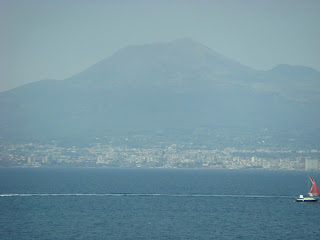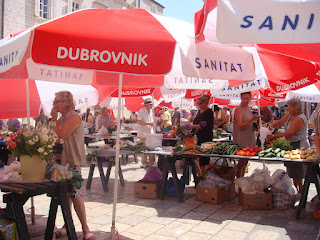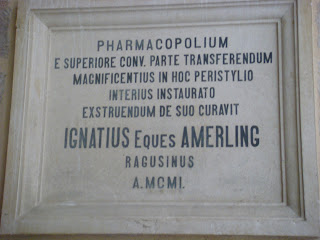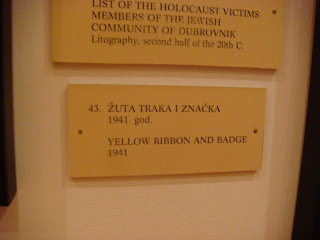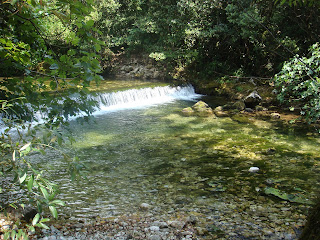Yesterday – the 27th June (an auspicious day) –
was a day at sea as we sailed from Dubrovnik to Naples.
The most visually interesting part was passage through the
Strait of Messina between Sicily and the coast of Italy. It is narrow and
requires the direction of a pilot who came on board from a highspeed boat and
left the same way after the transit.
Naples is the cruise ships entry point for this area and
there was a fleet in town for the day (and I’m sure that is the case all
summer). Together with land based tourists this means that there are crowds
everywhere.
We sailed into Naples early in the morning – and it
certainly looks beautiful from the ocean at a distance. From close up the area
around the dock, at least, was not very inviting.
Southern Italy has so much to offer in the way of beauty,
history and a wonderful way of life that a day here is simply a starter – have
to come back for more.
Regardless, we had to make a choice among all the tour
options – various combinations between Naples, Pompeii, Sorrento, Capri,
Positano and the Amalfi Coast. I know what Niki would have chosen!
We chose to do an all-day trip that included a morning in
Sorrento at our leisure followed by the afternoon on a walking tour of Pompeii.
The drive to Sorrento from Naples is by Autostrada through
the suburbs of Naples as far as Pompeii then by the winding coastal road that
takes you through (and in many cases above) the seaside towns.
The peaks of the Vesuvius complex looms over the valley as
we travel towards Pompeii and you can see how its eruption would have affected
a large area.
The Apennine mountain range, which forms the backbone of
Italy, then curves in to become the cliffs that drop down to the see and make
for such extravagantly beautiful scenery.
Over the centuries the residents of Campania have learned to
accommodate to the mountainous cliffs, the ocean and the climate in a way that
is truly harmonious.
Marinas and beaches can be seen at the waterside wherever
there is a reasonable area and there are boats – fishing and pleasure - all
over, swimming areas and sunbathing.
The cliffs have then been developed in terraces – the houses
with their colorful walls are built into the cliffs and rise layer upon layer
upward.
Around the houses, the fertile soil and wonderful
Mediterranean climate, have allowed the cultivation of an array of fruits,
vegetables and plants – again on terraces.
Olive trees were very common and are grown in groves with
rolled up nets between them – when the olives ripen they drop into the nets
(which have been spread between the trees for the purpose) and are harvested.
Grape vines are trellised vertically to save space.
We saw all manner of fruit trees but especially, as we got
closer to Sorrento, lemon trees (for which the area is famous) and other
citrus.
Our first view of Sorrento and the surrounding area of the
Bay of Naples with Capri in the distance was spectacular.
After leaving the bus in Sorrento we went off on our own to
explore. This is a sophisticated town with that has taken advantage of all its
natural resources! The seafront area is a walk down from the shopping area and
a Azamara cruise ship was docked in the bay. Beautiful Hotels offer views of the
ocean and access to the waterfront all along the frontage but are largely
hidden from the street.
Shopping, of course, was a major motivation for those
wandering the streets. The main road (Corso Italia) was lined with lemon trees
And parked scooters.
The side streets were narrow and offered all manner of
choices. The sweet liqueur limoncillo originates here – it consists of alcohol
that has been infused for days with the rind of local lemons then added sugar
syrup. Delicious. Had to buy a bottle. Innumerable stores offered their
variations on the theme.
Fruit stores selling local produce – the figs!!!!! Yum.
Took a shot of the shop that sells the cute wooden toys and
items we bought in Venice
We found a place that was selling Italian made kitchen and
home goods at excellent prices – the owner (Umberto) with whom we chatted – was
very vocal about the recession and the fact that, because of counterfeiting in
the East, anything of Italian design is very quickly copied and sold at low
price. We helped the economy as best we can (have to equip Vegas, right?)
Just being here even for so short a time gives off a vibe
that makes you absolutely need to come back.
Then it was back in the bus and the ride along that scary,
curvy wonderful mountain road to Pompeii.
The eruption of Mount Vesuvius in 79AD was catastrophic and
resulted in an enormous release of lava, white-hot ash and gas to a height of
20000 meters.
The sky was darkened for days and the sun was hidden but
fires started by the ash were extensive. Must have looked like hell!
Falling ash buried the cities of Pompeii and Herculaneum and
all they contained very rapidly to a depth of 3 meters and smothered all life.
Its hard for me to imagine that it was the ash fall that killed all the people
as they slept – maybe the gases as well?
Pliny the Younger was a soldier in the Roman Army stationed
nearby and described the event in his writings so the tragedy was not for
gotten or lost and excavations of Pompeii were begun as early as 1748.
By the time the area was excavated it had been buried,
encased in ash for nearly 2000 years and provides a fascinating look at the
sophistication of life in a Roman City of the time.
I am sure many of those reading this have visited Pompeii
and are familiar with it. The famous things to see.
I enjoyed particularly this glimpse of the day-to-day life
of a world so long gone yet so familiar (and in many ways so modern)
The streets and shops had names and were posted.
They were paved with well worn basalt and there were pedestrian crossings constructed across them to keep your feet out of the schmutz.
These raised rock crossings were low enough to avoid the
chariot axles. Smart.
The steel rimmed wheels wore ruts in the rocky road
Along the streets were stores with counters where you could
buy supplies – liquids like wine were kept in clay containers in the
counters.
Bread was baked on site – you can see the ovens still
the sidewalks had holes drilled in the rock to tie your carriage while you shopped / stopped
the sidewalks had holes drilled in the rock to tie your carriage while you shopped / stopped
Some of the houses had signs indicating their owners.
A brothel advertised with a sign appropriate to the
enterprise
Some of the walls on the street bear graffiti and some even
have written adverts – supporting a political candidate.
Houses of the patricians were beautifully thought through.
They had a vestibule with doors to shut out the street noise. A dining and
living area and a yard where a hole in the roof allowed in light and rainwater
to a pool below.
The walls of the houses, stores and buildings were decorated with frescoes some of
which survive to this day.
Romans were big on plumbing – we saw the original lead piping
that supplied water to houses and the pools.
We saw the ‘public toilet’ and baths in many locations. The
‘spa’ building of public baths had recesses in the wall for your clothes.
The height of the doors and the clearance above seating
indicates (just as you see in old England) people were short in stature.
Seating at the theater (which had different areas for people
of different status) was numbered and marked. The width of the seats suggests
plebeians were slim (unlike some of our fellow passengers)
Finally we saw the recently renovated amphitheater – where
the slaves had a go at each other and the lions etc. stood where Spartacus did
A final thought.
When the people of Pompeii died they were encased in ash.
Their bodies moulded the material around them. Over the years the moulds become
solid and their bodies decayed to dust. These plaster casts were made by filling
the impression created in ash.
The detail is uncanny. One man is a slave. Barefoot. Simple
clothes. His belt buckle has his owners name on.
The other figure is patrician. He is wearing clothes – like
a skirt. And sandles.
They say they died in their sleep. Asphyxiated.
The last major eruption of Vesuvius was in 1943
during the Italian Campaign of WW II – very well observed. hmmmmmmm







